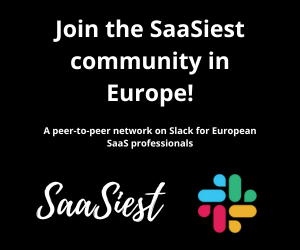Growth in the SaaS world isn’t a straight line. It’s messy, full of crises, and, at times, downright chaotic. But those very crises present the most valuable opportunities for reinvention. In a recent talk at SaaSiest, Jonathan Bean, the CMO of Sinch, shared his personal insights and strategies for steering through the turbulence of scaling a SaaS company from the ground up.
Jonathan kicked things off by acknowledging a common myth: the straightforward, linear path to SaaS success. “Boom, just follow the playbook, and there you go,” he said, highlighting how often founders are sold on the dream of exponential growth without understanding the bumpy road it actually takes to get there.
But the truth? It’s not always sunshine and stable growth charts. More often than not, the reality involves navigating through uncertainty, questioning leadership, and addressing internal crises before they spiral into bigger problems.
The Greiner Curve: A framework for understanding growth crises
At the heart of Jonathan’s talk was a deeper look into The Greiner Curve, an organizational growth theory from 1972 that outlines the stages of growth companies go through, from creation to maturity. This framework offers a powerful lens for modern SaaS businesses to understand that with every stage of expansion comes a crisis, and how they respond to those crises determines their future trajectory.
According to the Greiner Curve, companies pass through five stages of growth, each ending in a crisis of leadership, autonomy, control, or red tape. Jonathan pointed out that the modern B2B SaaS company faces a similar pattern, even if the details look a bit different in today’s landscape. At every stage, SaaS leaders must ask themselves: Who’s in charge?
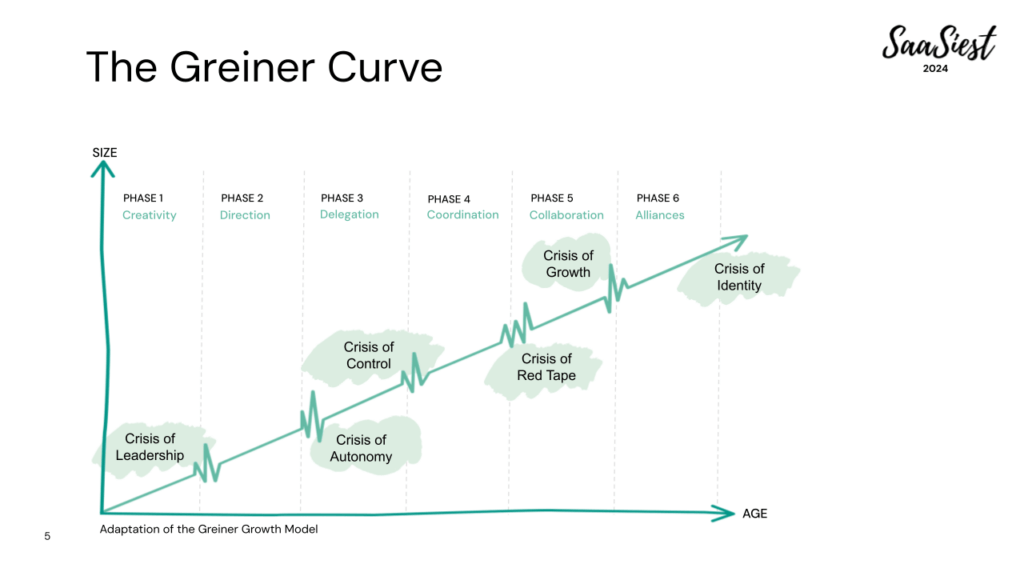
Jonathan outlined several key points when it comes to leadership and role definition during a company’s growth:
- Clarify roles early: It’s critical to distinguish between ownership and operational roles. Just because you’re the founder doesn’t mean you’re automatically in charge of day-to-day decisions.
- Distance ownership from operations: Founders need to separate their ownership stake from their operational responsibilities to ensure efficient decision-making.
- Avoid internal factions: Be cautious of divisions between tech, product, and go-to-market teams, as internal competition can hurt the company and slow growth.
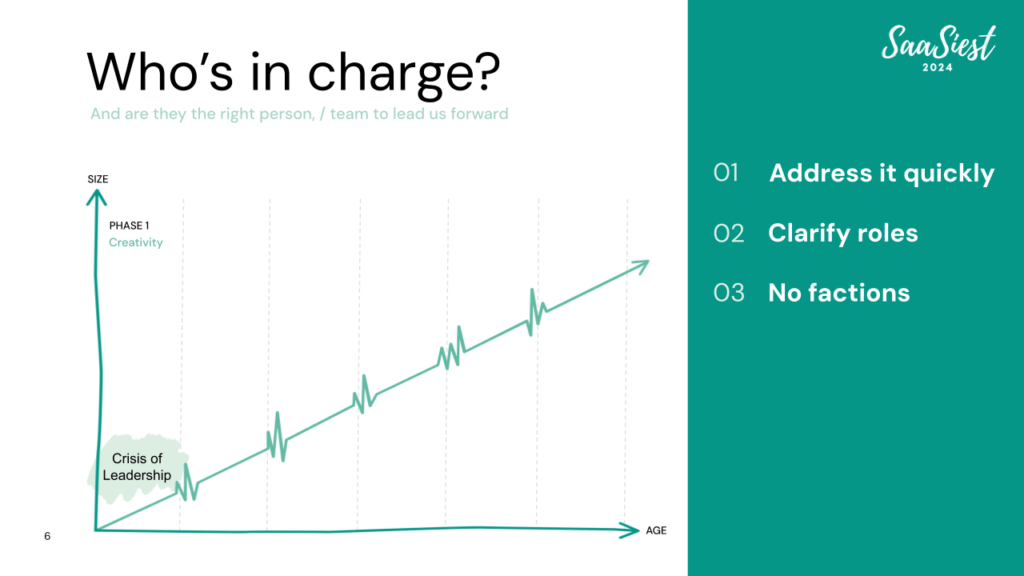
The art of reinvention
The secret to longevity in SaaS is reinvention at every stage. Your company, your product, and you as a leader need to evolve constantly. Drawing from his experiences at Mynewsdesk and Sinch, Jonathan described how pivotal it was for him to constantly reassess and realign his strategies through every crisis.
Jonathan called this process the “crisis of leadership,” where key decisions need to be made quickly. Founders and CEOs must distance themselves from operational roles when needed, and avoid allowing factions to form between teams—whether it’s product vs. go-to-market or tech vs. product. “No factions. They will hurt the company,” he said bluntly.
Global expansion
As SaaS companies scale internationally, it’s easy to be a national hero, but internationally – you’re a nobody.
Jonathan shared some candid advice from his own experience in expanding into new markets: don’t be cheap. He warned against the temptation to send a small, “backpack” team to save costs. Instead, companies should invest in hiring the right talent for each market, even if that means spending more upfront.
“Don’t compromise on culture,” Jonathan added. But evolving it to suit new regions is essential. He humorously recounted the challenge of translating Swedish ‘fika’ culture to the UK’s pub scene and how that adaptation is key to maintaining cultural relevance without losing your company’s core values.
Here are 5 key tips from Jonathan to have in mind when expanding globally:
- Invest in local talent: Don’t rely on sending a “backpack” team; hire market specialists who understand the local landscape.
- Tailor your strategy for each market: Adapt go-to-market strategies to reflect local customer preferences, pricing norms, and competition.
- Evolve your company culture: Ensure that your core values remain intact, but be flexible enough to adapt to cultural differences in new regions.
- Focus on local relevance: Make sure to localize the customer experience, from language and service to customer support, to build trust.
- Be strategic about new markets: Don’t expand everywhere at once—choose markets where your product has the best chance for success.
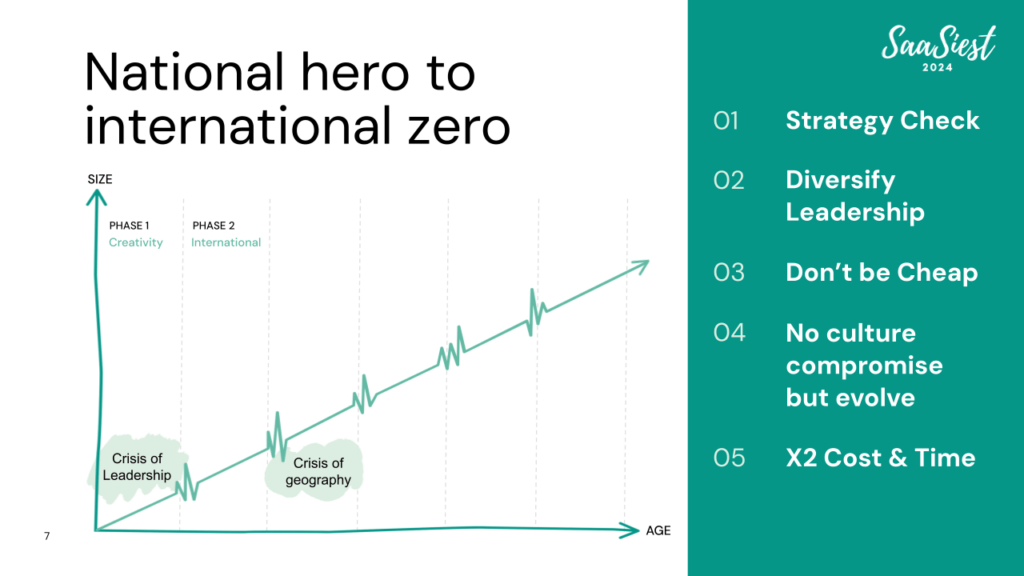
When to build, buy, or partner
Another tricky phase of growth that often leaves companies wondering whether to build, buy, or partner. Jonathan’s advice? Don’t build just because your engineers think they can. Instead, deeply assess whether you truly have a right to win in the new segment you’re entering.
He encouraged SaaS leaders to revisit their roadmaps and assess whether their new product fits their overall vision and ICP. And while on the subject of pricing, Jonathan admitted, “Most of the time, I’ve undercharged for product extensions.” He urged the audience to seize these moments of change as an opportunity to rethink pricing and packaging strategies. Here are Jonathans 5 tips for when to build, buy or partner:
- Determine whether you have a genuine advantage in building a new product internally or if it’s better to acquire or partner.
- Ensure any new product aligns with your company’s overall vision and ICP.
- Avoid the temptation to build new features or products solely because your team can. Instead, critically assess if it meets a real need and fits strategically.
- Use opportunities like new product extensions to reassess and potentially adjust your pricing and packaging strategies.
- Consider partnerships if they offer significant strategic value and can accelerate your entry into new markets or product areas.
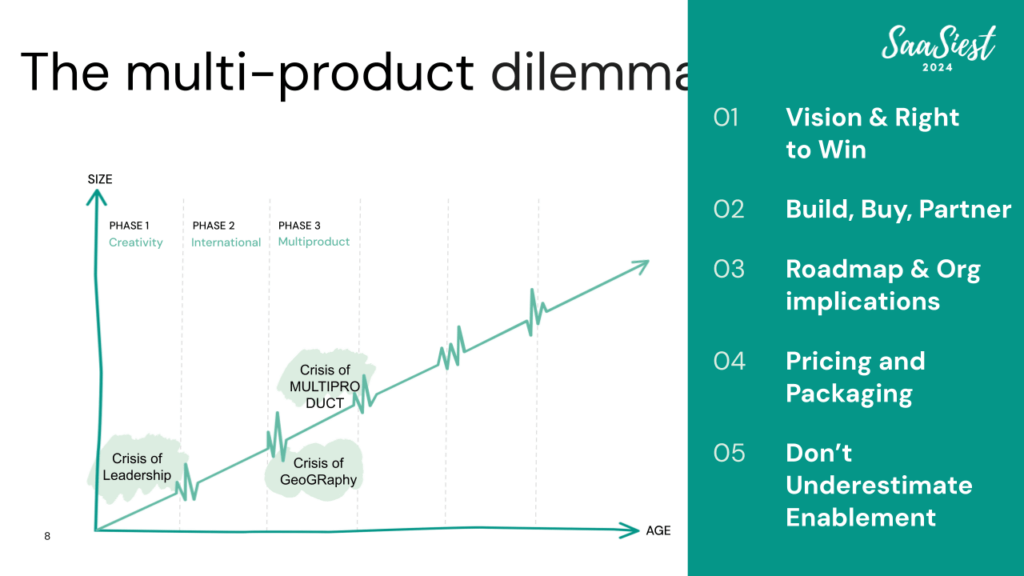
Adding new GTM-strategies: Do you really need It?
With the SaaS landscape changing so rapidly, especially with the rise of PLG (product-led growth) and other go-to-market strategies, Jonathan stressed the importance of not jumping on trends just because they’re hot. “Ask yourself, is it a must-have?” he said, pointing out that not every company needs to adopt every new strategy. While new go-to-market methods can offer opportunities, they should align with your core mission and strengths.
The human side of SaaS growth
Beyond business strategy, Jonathan shared a deeply personal aspect of his journey. “One of the most meaningful impacts I’ve had wasn’t ARR or an exit,” he confessed. Instead, it was the moment Sinch shipped 100 oxygen concentrators to their team in India during the COVID-19 crisis. It’s these human moments, Jonathan reminded the audience, that often matter most. Even in the relentless pursuit of SaaS growth, caring for your team and their well-being remains paramount.
While frameworks like the Greiner Curve can help outline growth stages, the reality is that every company faces unique challenges. The key takeaway for SaaS companies on their growth journey is that there’s no universal playbook. Embrace the uncertainties, navigate the crises, and recognize that reinvention at every stage is essential for long-term success—just as Sinch has demonstrated.



